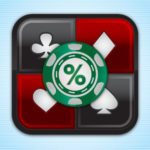Last week, we started a series called Back to Basics which is going to look at “basic” concepts in more depth than players have probably used before. Our first part of this series was on Implied Odds, and we’re going to continue with this theme in Part 2 this week with a look at Reverse Implied Odds.
In short, reverse implied odds are when you have a chance to hit outs that will cause you to lose money. For example, you might have a draw to a non-nut hand and get smashed by a player who makes the nuts instead. Figuring out how reverse implied odds play into your hand will help you to play a lot better in certain types of situations.
The Basic Nut vs. Non-Nut Draw Scenario
Suppose you have a nut flush draw on the turn out of position against a single opponent who you check to. The turn pot starts off at $10, and your opponent bets $5. You have the option to call. If you call, the river pot will be $20 and you will both have $20 behind. Suppose that if you call and hit your flush, you will always open shove for pot on the river, and you’ll never win the pot if you miss your flush. Your opponent will react by folding 40 percent of the time. About 60 percent of the time, you will get called and be paid off. Let’s calculate the EV of a call in this scenario based on these three possible outcomes:
- We miss our draw (37/46), we lose our $5 call.
- We hit our draw (9/46), our opponent folds the river (40%), we win the $10 turn pot and Villain’s $5 turn bet.
- We hit our draw (9/46), our opponent calls the river (60%), we win the $10 turn pot, Villain’s $5 turn bet and the $20 bet on the river.
EV of calling = (37/46)(-$5) + (9/46)(0.40)($10+$5) + (9/46)(0.60)($10+$5+$20)
EV of calling = -$4.02 + $1.17 + $4.11
EV of calling = $1.26
Now let’s change this scenario slightly so that we are incorporating reverse implied odds. We’re going to do this by changing what happens when we call and hit our draw. For this modified example, 40 percent of the time our opponent folds, 55 percent of the time we get paid off, and 5 percent of the time we stack off and lose on the river. Let’s find the EV of this new scenario using the updated outcomes:
- We miss our draw (37/46), we lose our $5 call.
- We hit our draw (9/46), our opponent folds the river (40%), we win the $10 turn pot and Villain’s $5 turn bet.
- We hit our draw (9/46), our opponent calls the river and we win (55%), we win the $10 turn pot, Villain’s $5 turn bet and the $20 bet on the river.
- We hit our draw (9/46), our opponent calls the river and we lose (5%), we lose the $5 turn call and $20 river bet.
EV of calling = (37/46)(-$5) + (9/46)(0.40)($10+$5) + (9/46)(0.55)($10+$5+$20) + (9/46)(0.05)(-$5-$20)
EV of calling = -$4.02 + $1.17 + $3.77 – $0.24
EV of calling = $0.68
What should stand out to you here is that a very small change with the reverse implied odds very seriously cut down the EV of calling. It wasn’t the most profitable play in the world when we had the nuts, but when we added reverse implied odds, it definitely wouldn’t be profitable if we added the rake.
The Anatomy of the EV
In the first scenario with the nut flush draw, the third outcome is the key source of our value. One of the things that happens when we add the non-nut stipulation is that our value from this scenario drops in a significant way. When you combine this from the negative EV we get from the newly-formed fourth outcome in the second example, you get a big difference between the EV of having the nuts and the EV of not having the nuts.
Alternative Options
Sometimes having severe reverse implied odds on a call can dampen your EV quite a bit. This can be an indicator to you that you should consider becoming the aggressor because it can be more likely that a semi-bluff would be more profitable than a call. One of the less obvious reasons that this is the case is that your opponent is less likely to call you with a bare draw that would beat you if you hit one of your outs.
For instance, if you were to shove on the turn in the second example above, you could probably get more than $0.68 worth of EV out of it depending on how often your opponent called you. However, one thing you could be sure of is that you would run into a better draw less often if you shove and get called than if you call yourself. In short, severe reverse implied odds will often be indicative of the need to prefer aggression over calling.
The Reason for the Nuts vs. Non-Nuts Comparison
You’ll notice that we did an EV calculation above looking at the same scenario based on whether or not we were drawing to the nuts. The reason for this was to illustrate that having reverse implied odds is a pretty big deal even if it only affects the outcome of the hand a small percentage of the time. Most people think of draws in terms of “I have X outs” and tend to avoid thinking about the implications of the reverse implied odds in the hand. Our goal here was to illustrate that even with just a small chance of getting outdrawn, the EV is affected in a major way.
Submit your review | |








